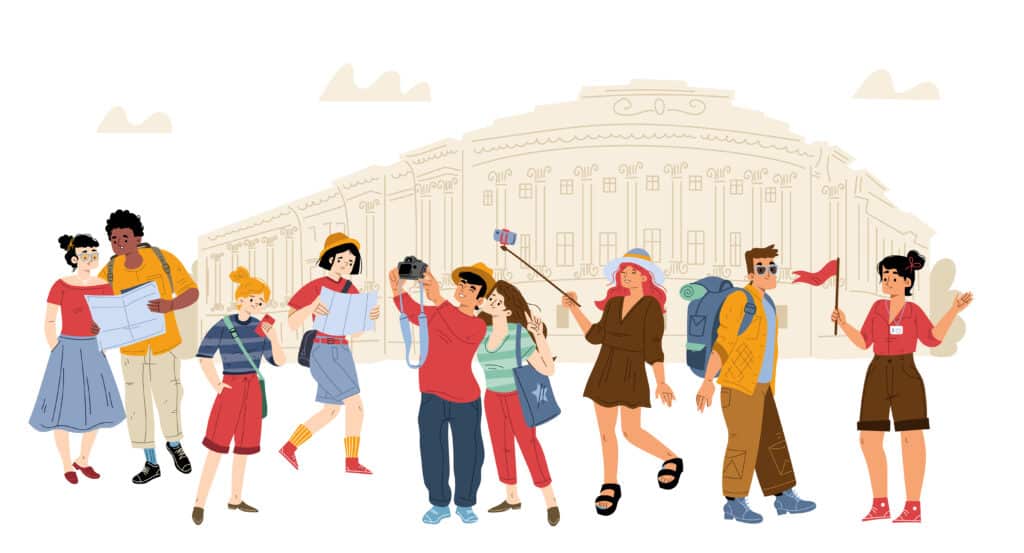Cultural tourism is a rapidly growing segment within the global travel industry, catering to individuals seeking to immerse themselves in local populations’ customs, traditions, and lifestyles. It combines the elements of leisure with an authentic experience of a destination’s unique historical, architectural, artistic, and culinary aspects. As a result, this form of tourism allows travellers to gain a deeper appreciation and understanding of different societies and their cultural characteristics.
In recent years, the demand for cultural tourism has been on the rise as more people are interested in exploring foreign customs and cultural experiences beyond the typical tourist attractions. This trend fosters cross-cultural connections and mutual understanding and creates positive economic and social impacts on local communities. By preserving and showcasing their traditions, local people have the opportunity to generate income and employment while maintaining a sense of pride in their cultural heritage.
With the increasing focus on sustainability and responsible tourism practices, cultural tourism sets itself apart by emphasizing the importance of engaging with local communities, adhering to ethical standards and minimizing negative impacts on the environment. As such, it presents a viable option for tourists who wish to expand their horizons while also contributing positively to the places they visit.
Table of Contents
Understanding Cultural Tourism

Cultural tourism is a significant and growing aspect of the global tourism industry. The United Nations World Tourism Organization (UNWTO) defines cultural tourism as the movement of people to cultural attractions away from their normal residence, with the intention of gathering new information and experiences that satisfy their cultural needs. It encompasses various activities undertaken by tourists to explore and experience different cultures, customs, and traditions.
One of the key aspects of cultural tourism is the opportunity it provides visitors to learn and engage with local communities, their history, and their way of life. This tourism is more than just visiting heritage sites or attending cultural events; it involves understanding and experiencing how people from different cultures live, express themselves through art, and maintain their traditions.
Cultural tourism fosters mutual understanding and respect between people from different cultural backgrounds. It encourages dialogue and exchange, breaking down social and cultural barriers and contributing to more tolerant societies. This form of tourism is an essential aspect of sustainable tourism development, as it seeks to preserve precious heritage for future generations while supporting economic growth for local communities.
As the tourism industry continues to grow, the demand for unique and authentic experiences increases. Cultural tourism serves to meet this demand by offering visitors the opportunity to immerse themselves in various cultural settings, fostering a deeper understanding of the world and its diverse cultures.
Importance of Cultural Tourism
Cultural tourism plays a significant role in society as it helps preserve and promote the values, beliefs, traditions, and heritage that define a particular culture. It allows individuals and communities to exhibit unique perspectives on arts, rituals, folklore, music, literature, language, oral traditions, and other cultural elements. Cultural tourism serves as a bridge between societies, aiding in fostering mutual respect, tolerance, and understanding among various cultures.
Economic benefits are also apparent through cultural tourism. Visitors contribute to the local economy, supporting local businesses and sustaining host communities’ cultural products and experiences. By engaging in cultural tourism, visitors gain an authentic understanding of indigenous and local cultures, empowering them to appreciate the rich diversity and uniqueness of the world.
Furthermore, cultural tourism helps preserve cultural heritage, vital for maintaining a sense of identity and continuity for future generations. This preservation and promotion of different cultures provide a sense of pride and belonging for people who are part of those traditions. In turn, this enhances cultural exchange, allowing individuals to learn about other ways of life while appreciating their values and beliefs.
Cultural tourism also supports the sustainability of performing arts and other creative industries. Through various interactions with artists and performers, visitors can develop an appreciation for a wide range of artistic expressions, contributing to the overall vitality of the art world.
Through the development of cultural tourism, a society can showcase its cultural heritage while contributing to its economic prosperity. By embracing the importance of cultural tourism, we can foster a greater understanding, appreciation, and celebration of the rich tapestry of customs, beliefs, and traditions that make up the world’s diverse cultures.
Types of Cultural Tourism

Cultural tourism allows travellers to immerse themselves in the history, heritage, and traditions of different places around the world. This form of tourism can be categorized into several types, each offering a unique way for visitors to experience and appreciate local cultures.
One type of cultural tourism is Historical and Heritage Tourism. This focuses on exploring sites related to a region’s past, such as ancient archaeological sites, monuments, and museums. It can instil a sense of wonder and appreciation for past civilizations’ achievements and teach travellers about the history of the places they visit.
Moving to the artistic side, Arts Tourism highlights the creative aspects of a culture. Tourists visit galleries, theatres, and concerts to experience local art, music, dance, and drama. It allows them to understand different communities’ aesthetic and expressive tendencies, opening their minds to new perspectives and forms of creativity.
Religious and Spiritual Tourism is another common form, where tourists visit religious sites, such as temples, churches, and mosques, or engage in spiritual practices like meditation and yoga. This type of cultural tourism can provide insights into various societies’ belief systems and rituals, fostering understanding and tolerance among people of different faiths.
However, culture isn’t just about history, arts, and religion but also daily life. Ethno and Indigenous Tourism involves tourists visiting and interacting with indigenous communities to learn about their customs, way of life, and unique perspectives on the world. This type of cultural tourism encourages empathy and cross-cultural understanding while emphasising respect for indigenous people’s rights and dignity.
Lastly, Culinary and Agritourism put emphasis on local food and drink traditions, as well as the agricultural practices that underpin them. This type of tourism can include attending food festivals, partaking in cooking classes or workshops, and visiting farms, vineyards, or breweries. Culinary experiences help tourists understand the richness of a region’s flavours and the relationship between local communities and their land and resources.
In summary, cultural tourism comes in various forms, appealing to different interests and tastes. It offers travellers a chance to explore and interact with diverse cultures, fostering connections and understanding among people around the world.
Forms of Cultural Tourism
Cultural tourism offers a wide range of experiences for travellers who seek to immerse themselves in different cultures, traditions, and ways of life. Various forms of cultural tourism cater to different interests and preferences.
Museums and galleries play a significant role in cultural tourism as they showcase a certain location’s history, art, and culture. Examples include art galleries displaying local and international masterpieces and museums featuring exhibits about the history and development of a specific region or theme.
Monuments and historic sites attract cultural tourists interested in exploring the past. Famous landmarks, archaeological sites, and heritage buildings tell the stories of civilizations and cultures that once thrived. UNESCO World Heritage Sites are often at the top of travellers’ lists, representing the world’s most significant cultural and natural heritage.
Architecture as a form of cultural tourism exposes tourists to varying architectural styles and meanings. Walking tours, cityscapes, and visits to iconic buildings provide a deeper understanding of a city’s architectural design’s cultural, social, and political influences.
Festivals and special events are another important aspect of cultural tourism, highlighting a particular community’s local customs and practices. These may include carnivals, parades, performances, traditional dances, and food festivals that provide a unique insight into the cultural identity of a place.
Gastronomy and cuisine play an integral role in the cultural tourism experience, as they allow tourists to savour the flavours and ingredients unique to a location. Local markets, food tours, cooking classes, and traditional restaurants all offer opportunities to appreciate the culinary heritage of a destination.
Shopping for crafts and textiles is a popular form of cultural tourism, as it allows travellers to bring home tangible memories of their journeys. Local artisans may showcase their talents through handmade textiles, pottery, jewellery, and other crafts, reflecting their community’s cultural heritage and artistic expression.
Cultural tourism encompasses diverse experiences, enabling travellers to engage with their chosen destination’s rich history, art, architecture, events, cuisine, and crafts. By exploring these varied aspects, visitors can deepen their understanding and appreciation of the world’s unique cultural landscapes.
Tangible and Intangible Cultural Attractions

Cultural tourism often focuses on two major aspects: tangible and intangible cultural attractions. These attractions shape a destination’s identity, providing depth and context for visitors and facilitating cultural exchange. This section will explore various facets of tangible and intangible attractions, comprehensively understanding their significance and diversity.
Tangible cultural attractions encompass elements of history, arts, and architecture that visitors can physically experience. Notable examples include monuments, visual art, and crafts that showcase local communities’ unique skills and traditions. Such attractions often reflect centuries of evolution and showcase the ingenuity of a region’s inhabitants. By visiting these sites and engaging with these art forms, travellers gain firsthand insights into the cultural heritage of their destination.
On the other hand, intangible cultural attractions comprise the non-material aspects of a culture that contribute to its unique characteristics and traditions. Music, social practices, festive events, and customs are some of the intangible elements that enrich the cultural landscape of a tourist destination. Interaction with local people plays a crucial role in understanding the region’s intangible cultural attractions, as they act as custodians of these traditions and their oral histories.
A dynamic interplay exists between tangible and intangible cultural attractions, creating a vibrant, multi-dimensional experience for tourists. For instance, the physical structure in architectural landmarks represents the tangible aspect, while the stories, legends, and rituals connected to the site contribute to its intangible allure. This symbiotic relationship reflects the essential interdependence between culture’s material and immaterial aspects.
In conclusion, tangible and intangible cultural attractions are indispensable pillars of cultural tourism. They provide an enriching experience for visitors and play a vital role in preserving and promoting a destination’s unique cultural heritage. Both aspects should be regarded with equal importance and cultivated to ensure a comprehensive and engaging experience for travellers seeking to explore a destination’s cultural offerings.
Advantages of Cultural Tourism
Cultural tourism provides a unique opportunity for individuals to immerse themselves in a particular society’s history, traditions, and customs. In doing so, they can develop a deeper understanding and appreciation of the diverse cultures that make up the world.
One significant advantage of cultural tourism is its potential to boost local economies. Tourist expenditures in local businesses such as hotels, restaurants, and shops can contribute to the growth and development of a region. Additionally, cultural tourism can create jobs, especially for local artisans, performers, and guides who offer authentic cultural experiences to visitors.
Another benefit of cultural tourism is the preservation and revitalization of cultural heritage. By attracting tourists interested in learning about and experiencing different traditions, communities are encouraged to preserve and maintain their cultural assets, such as historic sites, museums, and festivals. This helps ensure that future generations can continue to enjoy and learn from these valuable resources.
Cultural tourism also fosters cross-cultural understanding and appreciation. As people engage with diverse cultures, they may develop a broader perspective and a greater respect for cultural differences. This can lead to increased tolerance and harmony among different societies.
However, it is important to be aware of the potential disadvantages of cultural tourism. For instance, there may be issues related to overcrowding, environmental impact, or the commodification of cultural traditions. This makes it crucial to manage cultural tourism responsibly, ensuring it benefits both the tourists and the host communities.
Disadvantages of Cultural Tourism
Cultural tourism has gained popularity in recent years, drawing visitors from around the globe to experience and appreciate diverse cultures. However, this type of tourism also brings several disadvantages that must be considered.
One significant drawback of cultural tourism is the potential for commodification of cultures. As communities open their doors to tourists, they risk losing the authenticity and uniqueness of their cultural identity. Traditional practices and artefacts may be tailored to appeal to the tourist market, diluting their cultural significance.
Moreover, cultural tourism can put pressure on resources and spaces used by local communities. The influx of tourists may lead to overcrowding and increased competition for essential amenities. This could negatively impact the quality of life for local residents and strain the available infrastructure.
Another issue is the potential for environmental degradation resulting from cultural tourism. Some tourist activities may involve access to sensitive natural areas, leading to erosion, pollution, or disturbance of wildlife habitats. The construction of tourist facilities and infrastructure can also threaten the environment.
Lastly, cultural tourism can contribute to the unequal distribution of economic benefits. While some members of the community may profit from tourism-related businesses, others may not be able to participate in or benefit from these enterprises. This could exaggerate income disparities and create economic imbalances within communities.
In conclusion, despite cultural tourism’s numerous benefits to travellers and host communities, it is crucial to acknowledge and address its potential negative aspects. To ensure the long-term success of cultural tourism, policies and practices must be implemented that prioritize the protection of cultural and environmental resources and promote equitable distribution of economic benefits.
Cultural Tourism Destinations

Cultural tourism is a popular type of travel that allows visitors to immerse themselves in various destinations’ history, heritage, and traditions. Throughout the world, numerous places provide rich cultural experiences for travellers. Here, we explore a few notable cultural tourism destinations.
China is a vast and diverse country with a history dating back thousands of years. One can explore the architectural wonders of the Great Wall, the Terracotta Army in Xi’an, or the magnificent Forbidden City in Beijing. Visiting local markets and trying traditional cuisine also adds to the cultural experience in China.
India is another top destination for cultural tourism, offering many historical sites and vibrant traditions. The Taj Mahal in Agra, a UNESCO World Heritage Site, is a must-see with its iconic marble mausoleum. Another popular destination is Rajasthan, where the colourful cities and the royal palaces, such as the spectacular City Palace of Jaipur, offer a glimpse into the past.
France, specifically Paris, provides visitors with rich art, architecture, and cuisine. Iconic sites such as the Louvre, Notre Dame Cathedral, and the Eiffel Tower showcase the country’s artistic and architectural achievements throughout history.
Similarly, Spain is renowned for its rich cultural heritage with attractions such as the Alhambra in Granada, the Park Güell in Barcelona, designed by Gaudí, and the Prado Museum in Madrid.
Turkey, especially Istanbul, offers an intricate blend of European and Asian influences, with historic sites such as the Hagia Sophia, the Blue Mosque, and the Topkapı Palace. Moreover, the open-air bazaars and Turkish baths deliver an authentic cultural experience.
Italy, the birthplace of the Renaissance, is brimming with artistic and architectural masterpieces. Cities like Rome, Florence, and Venice are steeped in history, allowing visitors to marvel at landmarks like the Colosseum, St. Peter’s Basilica, or the Uffizi Gallery.
The beautiful island of Bali in Indonesia is known for its lush landscapes, Hindu temples, and vibrant arts scene, making it an excellent location for immersing oneself in the culture of the region.
Uzbekistan has gained attention recently as tourism grows along the Silk Road route. Visitors can admire the stunning architecture and mosaics of cities such as Samarkand, Bukhara, and Khiva, which capture the rich heritage of the ancient trading route.
In conclusion, cultural tourism invites travellers to explore fascinating destinations across the globe. While each location offers unique experiences, they provide a deeper understanding of human history, traditions, and heritage.
Stakeholders of Cultural Tourism

Cultural tourism is a multi-faceted industry that brings value to travellers in search of authentic experiences and to a myriad of stakeholders. From local communities to government bodies and from small businesses to environmental conservation efforts, cultural tourism can shape economies and lifestyles in both positive and negative ways. This guide delves into the key stakeholders in the cultural tourism sector, exploring their roles, impacts, and interconnected interests.
Tourists: The Heart of the Industry
Arguably, tourists are the backbone of cultural tourism. Whether they are history enthusiasts seeking out ancient ruins or gastronomes on the hunt for authentic local cuisine, tourists drive demand and shape the landscape of the tourism industry. They often seek enriching experiences that can offer a deep understanding of local cultures.
Local Communities: The Soul of the Destination
Local communities provide the lived experience that many cultural tourists seek. These people preserve the traditions, language, and heritage sites that form the basis of cultural tourism. Unfortunately, they can also bear the brunt of poorly managed tourism through cultural commodification and environmental degradation.
Government Bodies: The Framework Providers
Local and national governments play an instrumental role in regulating and promoting cultural tourism. They invest in infrastructure, enforce zoning laws, and facilitate public services like safety and sanitation that are vital to the tourism industry.
Tourism Boards and Agencies: The Promoters
Tourism boards, often funded by governments, are responsible for marketing a destination’s cultural assets to the world. These bodies work closely with other stakeholders to develop tourism packages, advertise local attractions, and even set guidelines for responsible tourism.
Tour Operators and Travel Agents: The Experience Curators
Specializing in delivering personalized experiences, these businesses are intermediaries between tourists and destinations. They can make or break the quality of the cultural tourism experience through their choices of local partnerships, itineraries, and guides.
Cultural Institutions: The Keepers of Heritage
Museums, art galleries, and historical sites are essential touchpoints for cultural tourists. They collaborate closely with various stakeholders to ensure that cultural assets are preserved and made accessible to the public.
Artisans and Performers: The Artistic Impressions
Artisans and performers add texture to the cultural fabric of a destination. These stakeholders benefit from increased visibility and economic opportunities, providing tourists a gateway to the authentic local culture.
Small Business Owners: The Local Economy Boosters
From restaurants and cafes to souvenir shops, small businesses see a surge in revenue when cultural tourism is thriving. They form a vital part of the local economy, providing services that enrich the tourist experience.
Academics and Researchers: The Thought Leaders
Cultural tourism is a field ripe for academic inquiry, touching upon anthropology, economics, and sociology disciplines. Research in this area can help shape policies that benefit tourists and local communities.
NGOs: The Advocates of Sustainability
Organizations that focus on cultural or environmental conservation often align with the interests of responsible cultural tourism. They act as watchdogs and advocates, ensuring that tourism practices are sustainable and ethical.
Real Estate Developers: The Infrastructure Builders
Though not directly related to the culture, real estate is essential in accommodating the influx of tourists, especially in booming destinations. They must balance business interests with responsible development.
Media: The Influencers
Media outlets, including travel bloggers and journalists, have a significant role in shaping public perception of a destination. Their storytelling can amplify the benefits or expose the pitfalls of cultural tourism.
The Environment: The Unspoken Stakeholder
Although not a traditional “stakeholder,” the environment stands to be significantly affected by tourism activities. Sustainable practices must be adopted to preserve the natural and cultural landscapes that attract visitors in the first place.
Understanding the intricate web of stakeholders in cultural tourism is the first step in creating an industry that benefits all. As cultural tourism evolves, stakeholders must actively dialogue to ensure sustainable and enriching experiences for everyone involved.
Cultural Tourism Experience
Cultural tourism experiences provide a unique opportunity for travellers to immerse themselves in the local culture, customs, and traditions of the places they visit. These immersive travel experiences enable tourists to understand the heritage and identity of the communities they encounter.
One popular way to experience cultural tourism is through homestays. These accommodations offer the chance to live with a local family, providing a firsthand glimpse into their daily lives and customs. The cultural exchange within a homestay environment can be transformative, offering insights that would otherwise remain veiled during a typical sightseeing vacation.
Another important aspect of cultural tourism is engaging with the local communities, participating in their events and festivals, and learning about their history and heritage through interactions with the people there. These experiences enable travellers to connect meaningfully with locals, fostering mutual appreciation and understanding of different cultures.
Cultural experiences often focus on different dimensions, such as:
- Arts and crafts: Exploring local artisans’ craftsmanship and heritage by visiting workshops, galleries, and markets.
- Cuisine: Sampling regional culinary specialities can offer a taste of local culture, traditions, and history.
- Religious sites: Visiting places of worship offers insight into the spiritual beliefs and practices of the area.
- Performing arts: Engaging with local music, dance, and theatre performances can reveal unique cultural perspectives and expressions.
Cultural tourism emphasizes responsible travel and encourages visitors to respect and appreciate the local customs, traditions, and the natural environment while exploring new destinations. Tourists can create unforgettable memories by connecting with people from different backgrounds and gaining a deeper understanding of their practices and values, fostering greater global empathy and cultural appreciation.